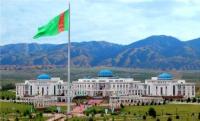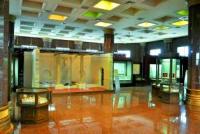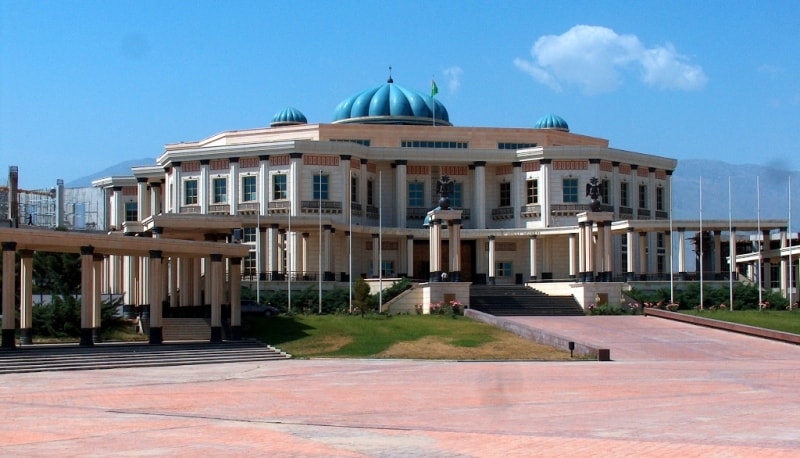You are here
State museum in Ashgabad.




Museum Ashgabad tours.
"The exposition is located on two floors and consists of eight rooms. The ground floor space is formed by round hall; the dome is divided into sixteen hemispheres and supported by twenty-five columns.
In the center of the atrium state symbols are formed: the flag, coat of arms, and showcases with the documents of Independence, neutrality, anthem, flag and constitution"
Excursion to State museum in Ashgabad.
Welcome to the State Museum of the State cultural centre Turkmenistan, to its central building, which is devoted to the exposition of centuries-old history of Turkmenistan. You can take a fascinating journey into the world of the past, recall the historical events and see the original subjects of different ages.
The exposition is located on two floors and consists of eight rooms. The ground floor space is formed by round hall; the dome is divided into sixteen hemispheres and supported by twenty-five columns.
In the center of the atrium state symbols are formed: the flag, coat of arms, and showcases with the documents of Independence, neutrality, anthem, flag and constitution. The first room is dedicated to the Independence of Turkmenistan, to the achievements that have been implemented over the years.
The tour route visitors get to the second floor and begin acquaintance with ancient history, namely with the map which outlines the key archaeological monuments of Turkmenistan and continue it in the hall "Ancient World".
Room is devoted to the earliest beginning of human history and the first stage of settlement of primitive people in our country and to the history of the first city and state on the territory of Turkmenistan.
There are such large flint flakes related to the Upper Palaeolithic (60 thousand years BC), small flint flakes that are used as liners for knives, as well as employed arrowheads of Mesolithic period (12 thousand years BC .).
Jeytun culture of the Neolithic period which was the first settlement in Central Asia (6 thousand years BC); the tools and rough molding band ceramics unevenly baked, decorated wavy lines, filled with mineral paints from eneolit (4 thousand years BC) - a sophisticated ceramic pottery, made on the potter's wheel.
Early urban culture with the settlement of Altyn-depe and its presented seals, ceramics, and layout of the temple in the form of Mesopotamian ziggurat. Most of the room is devoted to the country Margush that existed in the III - II centuries BC in the ancient delta of the Murghab River in Mary province.
Here is the grand architecture of the cities, temples, forts, as well as the high skill of the ancient craftsmen, potters, jewelers. They were masters of microscopic craftsmanship of gold, turquoise and carnelian.
Gold and silver vessels admire the elegance and sophistication. A large number of seals and cosmetic accessories made of silver, bronze, stone, bone, decorated with scenes of mystical mythology, amazing variety of forms and technologies.
Hall of antiquity tells us about Old Nisa - one of the first capitals of the Great Parthian Empire, which was the residence of the treasury and the Parthian rulers. The room contains unique pieces of architecture, miniature figurines of Athena, Eros, eagle, griffin made of silver and gilding, which amaze with their delicate depictions of small details.
A special pride of the museum are rhytons made of ivory, frieze of which was ornamented with scenes from Greek mythology, smooth trunk decorated with floral relief and ended with the image of a mythical creature. In ancient times they were inlaid with precious stones and metals.
Rhytons are made with the principle of the golden section. In the halls of "Middle Ages" are exhibited unique archaeological finds from the V century AD - fragments of Buddhist architecture, statues and amphora reliquary found immured in a mortar, covered with paintings. Inside of which were stored Buddhist texts in Sanskrit.
Also there are presented dishes decorated with inscriptions in Arabic, luster ceramics, gold and silver coins of the medieval states. Tour continues on the first floor in the hall of Turkmen carpets, where pride of Turkmen people ‒ giant carpet is exhibited, area of which is 266 square meters.
Main ornament is gushly gel – pattern of Akhal-teke tribe. Also in the showcases of this room are presented the unique rugs of XIX - XX centuries. View the complete exposition hall, at which temporary exhibitions of important dates and holidays of our nation are hold.

Authority and photos:
http://www.museum.gov.tm and Alexander Petrov.






